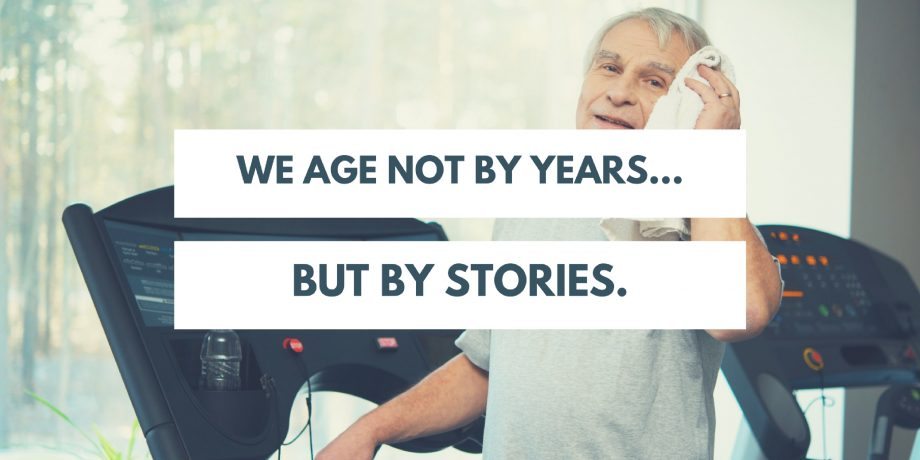5 HIIT Workouts That Are Perfect for Older Adults
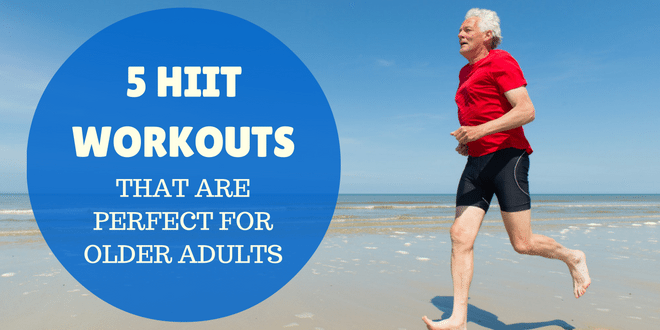
High-intensity interval training (HIIT) has taken the fitness industry by storm in recent years primarily due to the amazing results it provides in such a short amount of time. For those of you who don’t know, HIIT is a method of training where you alternate short intervals of all-out exertion (such as sprints) with active rest periods (such as walking) for a total of just 10-20 minutes.
As simple as it sounds, this type of training has been proven to give superior results compared to the typical steady-state cardio routine. In fact, scientists at McMaster University found that just 1 minute of all-out exercise (performed in a HIIT way) provides the same benefits as 45 minutes of moderate cardio.

The “catch” with HIIT is that it requires a very high exertion level. This becomes increasingly harder to do as you age due to your slower recovery and general aches and pains. But at the same time, older adults need vigorous exercise to support muscle mass, keep their bones healthy, and to help them with everyday activities such as climbing stairs or recovering when stumbling. And there’s more good news. A follow-up study done by the McMaster researchers found that even with decreasing the intensity of the workout, people still enjoyed the same benefits. This means that even if you can’t perform interval training at a very high intensity, you’ll still reap the majority of its benefits.
My father who is now 65 years old performs HIIT 2-3 times a week. It has helped him lower his blood pressure, build muscle mass, lose fat, and improve his cardiovascular fitness. However, HIIT was not always the best option for him. He has had 2 knee replacements, 1 hip replacement, and was diagnosed with COPD (chronic obstructive pulmonary disease). This made performing vigorous exercise next to impossible for him. But the key that helped him was starting at lower levels and building up slowly. I designed an interval training program that he could gradually progress with until he was able to do it with high intensity. There are many ways to do this. And in this article, I’m going to show you 5 different HIIT workouts that are perfect for older adults to blend into their workout regimen.
** Please make sure that you have clearance from your doctor before performing any of the following exercises. Stop the exercise if you feel dizzy, sick, have muscle cramps, or have uncomfortable pain or pressure anywhere in your body. I also recommend that you stretch for at least 10 minutes before performing any HIIT exercises to reduce the risk of injury. It is also a good idea to gather more info on your health insurance coverage to ensure that you are protected while you work out.
Comparison sites like this one from Australia are a good place to start.
A treadmill is a great tool for interval training as it allows you to adjust the difficulty of your work interval. Here’s the workout:
Warm up: 5-minute walk or slow jog
Work interval: 20 seconds “sprint”
Rest interval: 90 seconds walk
Repeat 4-6 times
Cool down: 5-minute walk
This is the basic structure of the treadmill HIIT workout. What you want to do is adjust the speed and incline of the treadmill during the “sprint” to suit your fitness level. When first starting out, you want to support a level in which you’re out of breath but can still hold up a conversation. And as you progress throughout several weeks of doing this, you want to work towards a level in which you’re so out of breath throughout the workout that you can hardly keep up a conversation. I suggest that every week you either increase the speed or incline of the treadmill to keep your body improving every week.
You can do this workout once a week in the beginning, and build up to performing it 2-3 times a week. But go with how your body feels and adjust the workout accordingly.
This is another great piece of equipment that allows you to easily do HIIT in a controlled environment. It’s also a great exercise for building muscle mass and strength in your leg muscles.
Warm up: 5 minutes of light cycling
Work interval: 20 seconds of cycling at max intensity
Rest interval: 90 seconds of light cycling
Repeat 4-6 times
Cool down: 2 minutes of light cycling followed by 2 minutes of walking
As in the sprints workout, you can adjust the resistance and intensity of your work interval to better suit your current fitness level. And as the weeks go by you can increase the resistance and intensity, or even add more work intervals into the workout to keep your body progressing.
This workout is a little more complex and requires more coördination than the previous workouts. With that being said, it’s a great way to workout both your muscles and cardiovascular system simultaneously and will help strengthen your bones.
Warm up: arm swings followed by 3-5 minutes of walking
For the workout, you’ll be performing 4 exercises consecutively without any rest. After completing the 4 exercises, you will take a 90-second rest and then repeat the circuit again 3-5 times. As you get stronger, increase the weight or reps of each exercise performed. Pick an appropriate weight for each exercise that allows you to do each movement with proper form.
Exercise 1 – One-arm dumbbell row (10 reps each side)
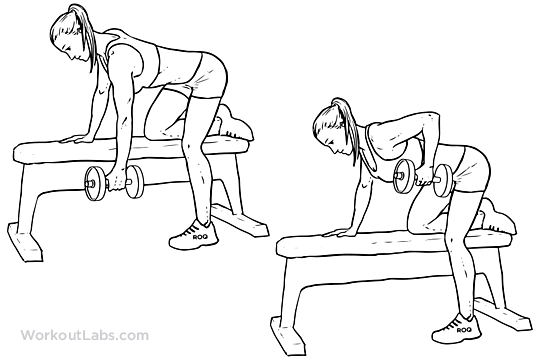
Tips: Place one arm and corresponding knee on the bench. Keep your back neutral and keep your core engaged. Pull the dumbbell up to your side and repeat.Exercise 2 – Wall ball squats (12 reps)
Exercise 2 – Wall ball squats (12 reps)
Tips: This is a great exercise to help you throughout your squat. Place a stability ball between your back and a wall. Place your feet forward at about shoulder width apart. Lower yourself down until your thighs are parallel with the ground, and then push back up. Keep your core tight and back straight throughout the movement.
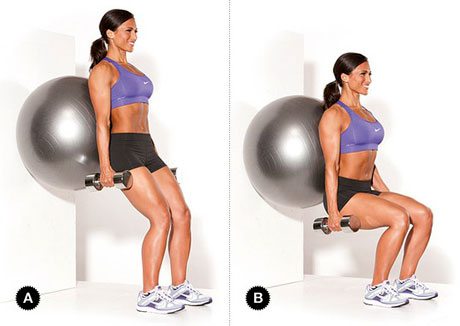
Exercise 3 – Standing dumbbell press (10 reps)
Tips: Stand straight and lift the two dumbbells over your head and back down again. Keep your back straight throughout the movement.
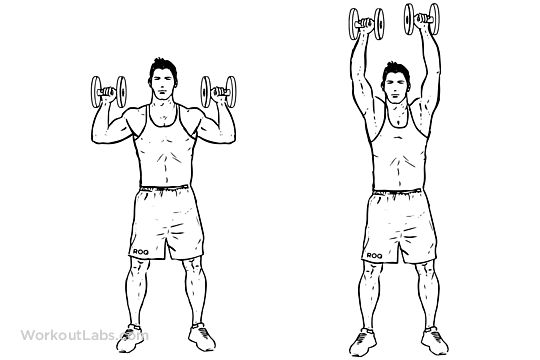
Exercise 4 – Front plank (30 seconds or as long as possible)
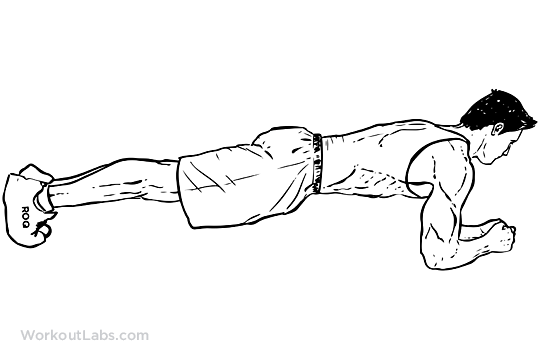
Tips: Facing the floor, get onto your forearms and toes. Keep your abs engaged, and create a straight line from your toes to shoulders. Hold this position.
Swimming is an excellent way for older adults to incorporate HIIT. It provides the opportunity for those who are overweight or have arthritis to still exercise at higher intensities without the joint stress typically associated with high-intensity workouts. Warm up before the workout for 5-10 minutes by swimming at a slow pace with whatever strokes you will be using in the workout.
Feel free to use whatever stroke (or the combination of strokes) you’d like to during the workout. Major strokes include freestyle, backstroke, breaststroke, or butterfly. If you’re new to swimming, the freestyle is usually the best option to start with. In the work interval it says to “sprint”, but as mentioned above you should choose the pace that suits your fitness level. Just make sure that you’re working at the highest intensity possible that doesn’t cause pain or extreme discomfort.
Work interval: 1 lap sprint
Rest interval: Slow swim 1 lap
Repeat 4-6 times.

This is a fun way to get your HIIT workout in and helps improve your overall coordination. Basically, you’ll be hitting the bag, however, you want (“freestyle”) and with as high intensity as possible for 30 seconds and then alternating with a rest period. I recommend mixing in a variety of moves such as a jab crosses, hooks, upper cuts, etc. Just make sure you’re hitting the bag with a high intensity throughout the work period. And make sure you wear the proper gloves! Warm up appropriately with arm swings and light punches.
Work interval: 30 seconds “freestyle” at max intensity
Rest interval: 60-90 seconds walking around
Repeat 4-6 times
There you have it! 5 HIIT workouts that are perfect for older adults.
I recommend incorporating HIIT workouts for a maximum of 3 workouts a week. So to start, choose 1 of these workouts and try it out once a week. As your fitness level improves you can do more sessions and add different workouts. But the key is to stay consistent with it and try to progress every week whether you are adding more weight, adding more reps, or performing the exercise at a slightly higher intensity. Enjoy!
[divider style="dashed" top="30" bottom="30"]
Jeremy is a Kinesiologist and certified personal trainer from Vancouver, Canada. He is the creator of HIIT Your Body where he provides anything and everything HIIT. From full on 8 weeks HIIT workout plans to quick 20-minute home workouts, you can find it on his site.
[divider style="dashed" top="30" bottom="30"]
As simple as it sounds, this type of training has been proven to give superior results compared to the typical steady-state cardio routine. In fact, scientists at McMaster University found that just 1 minute of all-out exercise (performed in a HIIT way) provides the same benefits as 45 minutes of moderate cardio.

The “catch” with HIIT is that it requires a very high exertion level. This becomes increasingly harder to do as you age due to your slower recovery and general aches and pains. But at the same time, older adults need vigorous exercise to support muscle mass, keep their bones healthy, and to help them with everyday activities such as climbing stairs or recovering when stumbling. And there’s more good news. A follow-up study done by the McMaster researchers found that even with decreasing the intensity of the workout, people still enjoyed the same benefits. This means that even if you can’t perform interval training at a very high intensity, you’ll still reap the majority of its benefits.
My father who is now 65 years old performs HIIT 2-3 times a week. It has helped him lower his blood pressure, build muscle mass, lose fat, and improve his cardiovascular fitness. However, HIIT was not always the best option for him. He has had 2 knee replacements, 1 hip replacement, and was diagnosed with COPD (chronic obstructive pulmonary disease). This made performing vigorous exercise next to impossible for him. But the key that helped him was starting at lower levels and building up slowly. I designed an interval training program that he could gradually progress with until he was able to do it with high intensity. There are many ways to do this. And in this article, I’m going to show you 5 different HIIT workouts that are perfect for older adults to blend into their workout regimen.
[tweet_box design="box_9"]Age is a matter of mind over matter - if you don't mind, it doesn't matter. - Mark Twain[/tweet_box]
5 HIIT Workouts that are Perfect for Older Adults
** Please make sure that you have clearance from your doctor before performing any of the following exercises. Stop the exercise if you feel dizzy, sick, have muscle cramps, or have uncomfortable pain or pressure anywhere in your body. I also recommend that you stretch for at least 10 minutes before performing any HIIT exercises to reduce the risk of injury. It is also a good idea to gather more info on your health insurance coverage to ensure that you are protected while you work out.
Comparison sites like this one from Australia are a good place to start.
Workout 1: The Treadmill
A treadmill is a great tool for interval training as it allows you to adjust the difficulty of your work interval. Here’s the workout:
Warm up: 5-minute walk or slow jog
The Treadmill workout
Work interval: 20 seconds “sprint”
Rest interval: 90 seconds walk
Repeat 4-6 times
Cool down: 5-minute walk
This is the basic structure of the treadmill HIIT workout. What you want to do is adjust the speed and incline of the treadmill during the “sprint” to suit your fitness level. When first starting out, you want to support a level in which you’re out of breath but can still hold up a conversation. And as you progress throughout several weeks of doing this, you want to work towards a level in which you’re so out of breath throughout the workout that you can hardly keep up a conversation. I suggest that every week you either increase the speed or incline of the treadmill to keep your body improving every week.
You can do this workout once a week in the beginning, and build up to performing it 2-3 times a week. But go with how your body feels and adjust the workout accordingly.
Workout 2: Cycling
This is another great piece of equipment that allows you to easily do HIIT in a controlled environment. It’s also a great exercise for building muscle mass and strength in your leg muscles.
Warm up: 5 minutes of light cycling
The Cycling workout
Work interval: 20 seconds of cycling at max intensity
Rest interval: 90 seconds of light cycling
Repeat 4-6 times
Cool down: 2 minutes of light cycling followed by 2 minutes of walking
As in the sprints workout, you can adjust the resistance and intensity of your work interval to better suit your current fitness level. And as the weeks go by you can increase the resistance and intensity, or even add more work intervals into the workout to keep your body progressing.
Workout 3: Dumbbell Circuit
This workout is a little more complex and requires more coördination than the previous workouts. With that being said, it’s a great way to workout both your muscles and cardiovascular system simultaneously and will help strengthen your bones.
Warm up: arm swings followed by 3-5 minutes of walking
The dumbbell Circuit workout
For the workout, you’ll be performing 4 exercises consecutively without any rest. After completing the 4 exercises, you will take a 90-second rest and then repeat the circuit again 3-5 times. As you get stronger, increase the weight or reps of each exercise performed. Pick an appropriate weight for each exercise that allows you to do each movement with proper form.
Exercise 1 – One-arm dumbbell row (10 reps each side)

Tips: Place one arm and corresponding knee on the bench. Keep your back neutral and keep your core engaged. Pull the dumbbell up to your side and repeat.Exercise 2 – Wall ball squats (12 reps)
Exercise 2 – Wall ball squats (12 reps)
Tips: This is a great exercise to help you throughout your squat. Place a stability ball between your back and a wall. Place your feet forward at about shoulder width apart. Lower yourself down until your thighs are parallel with the ground, and then push back up. Keep your core tight and back straight throughout the movement.

Exercise 3 – Standing dumbbell press (10 reps)
Tips: Stand straight and lift the two dumbbells over your head and back down again. Keep your back straight throughout the movement.

Exercise 4 – Front plank (30 seconds or as long as possible)

Tips: Facing the floor, get onto your forearms and toes. Keep your abs engaged, and create a straight line from your toes to shoulders. Hold this position.
Workout 4: Swimming
Swimming is an excellent way for older adults to incorporate HIIT. It provides the opportunity for those who are overweight or have arthritis to still exercise at higher intensities without the joint stress typically associated with high-intensity workouts. Warm up before the workout for 5-10 minutes by swimming at a slow pace with whatever strokes you will be using in the workout.
Feel free to use whatever stroke (or the combination of strokes) you’d like to during the workout. Major strokes include freestyle, backstroke, breaststroke, or butterfly. If you’re new to swimming, the freestyle is usually the best option to start with. In the work interval it says to “sprint”, but as mentioned above you should choose the pace that suits your fitness level. Just make sure that you’re working at the highest intensity possible that doesn’t cause pain or extreme discomfort.
The Swimming workout
Work interval: 1 lap sprint
Rest interval: Slow swim 1 lap
Repeat 4-6 times.
Workout 5: Boxing

This is a fun way to get your HIIT workout in and helps improve your overall coordination. Basically, you’ll be hitting the bag, however, you want (“freestyle”) and with as high intensity as possible for 30 seconds and then alternating with a rest period. I recommend mixing in a variety of moves such as a jab crosses, hooks, upper cuts, etc. Just make sure you’re hitting the bag with a high intensity throughout the work period. And make sure you wear the proper gloves! Warm up appropriately with arm swings and light punches.
The Boxing Workout
Work interval: 30 seconds “freestyle” at max intensity
Rest interval: 60-90 seconds walking around
Repeat 4-6 times
There you have it! 5 HIIT workouts that are perfect for older adults.
I recommend incorporating HIIT workouts for a maximum of 3 workouts a week. So to start, choose 1 of these workouts and try it out once a week. As your fitness level improves you can do more sessions and add different workouts. But the key is to stay consistent with it and try to progress every week whether you are adding more weight, adding more reps, or performing the exercise at a slightly higher intensity. Enjoy!
[divider style="dashed" top="30" bottom="30"]
 Author Bio: Jeremy Ethier
Author Bio: Jeremy Ethier
Jeremy is a Kinesiologist and certified personal trainer from Vancouver, Canada. He is the creator of HIIT Your Body where he provides anything and everything HIIT. From full on 8 weeks HIIT workout plans to quick 20-minute home workouts, you can find it on his site.
[divider style="dashed" top="30" bottom="30"]

